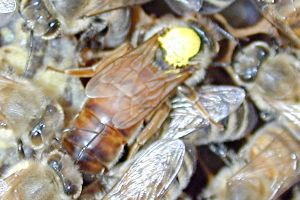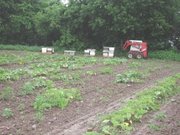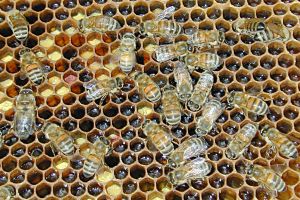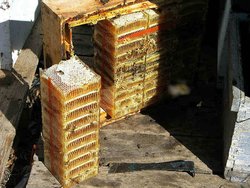Honeybee
|
|
| Honeybee Conservation status: Secure | ||||||||||||||||||
|---|---|---|---|---|---|---|---|---|---|---|---|---|---|---|---|---|---|---|
| Missing image Honigbiene.JPG Honeybee | ||||||||||||||||||
| Scientific classification | ||||||||||||||||||
| ||||||||||||||||||
| Species | ||||||||||||||||||
|
A. mellifera — western honeybee |
The honeybee is a colonial insect that is often maintained, fed, and transported by farmers. Honeybees are a subset of bees which fall into the Order Hymenoptera and Suborder Apocrita. Of the approximately 20,000 known species of bees, four are considered honeybees: Apis florea, Apis dorsata, Apis cerana, and Apis mellifera (Western honeybee). They have been domesticated at least since the time of the building of the Egyptian pyramids.
Honeybees store honey (which is made from nectar) in their hives, which provides the energy for flight muscles and for heating during the winter period, and pollen which supplies protein for bee brood to grow. Through centuries of selective breeding, honeybees can produce far more honey than the colony needs. Beekeepers, also known as "apiarists", harvest the honey and supply sugar for the winter.
| Contents |
Origin and distribution
Bee_on_crocus.jpg
Bees_Collecting_Pollen_2004-08-14.jpg
Honeybees probably originated in Tropical Africa and spread from South Africa to Northern Europe and East into India and China. The first bees appear in the fossil record in deposits dating about 40 million years ago during the Eocene period. At about 30 million years before present they appear to have developed social behavior and structurally are virtually identical with modern bees.
Apis mellifera, the most commonly domesticated species, is native to Europe, Asia and Africa. It is also called the Western honeybee. There are many sub-species that have adapted to the environment of their geographic and climatic area. Behavior, color and anatomy can be quite different from one sub-species or race to another. The sub-species Apis mellifera mellifera were brought to the Americas with the first colonists to Virginia in 1622, and numerous other occasions later. Many of the crops that depend on honeybees for pollination have also been imported since colonial times. Escaped swarms (known as wild bees, but actually feral) spread rapidly as far as the Great Plains, usually preceding the colonists. The Native Americans called the honeybee "the white man's fly." Honeybees did not naturally cross the Rockies; they were carried by ship to California in the early 1850s.
Beekeeping
Beekeepers often provide a place for the colony to live and to store honey in. There are three basic types of beehive: skeps, Langstroth hives and top-bar hives. The type of beehive used has a significant impact on the ability to keep the colony healthy and on the amount of wax and honey that the colony can produce.
Modern hives also enable beekeepers to transport bees, moving from field to field as the crop needs pollinating and allowing the beekeper to charge for the pollination services they provide.
In cold climates, some beekeepers have kept colonies alive (with varying success) by moving them indoors for winter. While this can protect the colonies from extremes of temperature and make winter care and feeding more convenient for the beekeeper, it can increase the risk of dysentery (see the Nosema section of diseases of the honeybee) and can create an excessive buildup of carbon dioxide from the respiration of the bees. Recently inside wintering has been refined by Canadian beekeepers who build large barns just for wintering bees. Automated ventilation systems assist in the control of carbon dioxide build-up.
Honeybee life cycle
Like other eusocial bees, a colony generally contains one breeding female, or "queen"; a few thousand males, or "drones"; and a large population of sterile female workers. The female workers mature from nurse bees to become foragers. The foragers die usually when their wings are worn out after approximately 500 miles of flight.
The population of a healthy hive in mid-summer can average between 40,000 and 80,000 bees. The workers cooperate to find food and are widely believed to use a pattern of "dancing" (known as the bee dance or waggle dance) to communicate with each other.
Honeybee stings
Honeybees will sting when they perceive the hive to be threatened. A honeybee that is away from the hive foraging for nectar or pollen will rarely sting. A honeybee can sting only once. It injects apitoxin through the stinger. The stinger is a modified ovipositor. It has barbs which lodge in the skin. As the bee pulls away, the stinger rips loose from the bee's abdomen. During this process, the bee will also release alarm pheromones along with the stinger. The bee dies soon after it releases the stinger. Upon the bee's release of alarm pheromones, it attracts other bees to the location in their defensive behaviors.
The larger drone bees have no stingers at all. The queen bee has a smooth stinger and could sting multiple times, but the queen does not leave the hive under normal conditions. Her stinger is not for defense of the hive; she only uses it for dispatching rival queens. Queen breeders who handle multiple queens and have the queen odor on their hands sometimes are stung by a queen.
Products of the honeybee
Pollination
The honeybee's primary commercial value is as a pollinator of crops. As an example, in California, the pollination of almonds occurs early in the growing season, before local hives have built up their populations. Almond orchards require two hives per acre (2,000 m² per hive) for maximum yield and so the pollination is highly dependent upon the importation of hives from warmer climates.
Honey
Main article: Honey
Honey is the substance made when the nectar and sweet deposits from plants are gathered, modified and stored in the honeycomb by honey bees.
Beeswax
Main article: Beeswax
Worker bees of a certain age will secrete beeswax from a series of glands on their abdomen. They use the wax to form the walls and caps of the comb. When honey is harvested, the wax can be gathered to be used in various wax products like candles and seals.
Pollen
Main article:Pollen
Bees collect pollen in the pollen basket and carry it back to the hive. In the hive, pollen is used as a protein source necessary during brood-rearing. In certain environments, excess pollen can be collected from the hive. It is often eaten as a health supplement.
Propolis
Main article: Propolis
Propolis (or bee glue) is created from resins and tree saps. Honeybees use propolis to seal cracks in the hive. Propolis is also sold for its reported health benefits.
Bee problems
- North American and European honeybee populations were severely depleted by varroa mite infestations in the early 1990s. Chemical treatments saved most commercial operations and improved cultural practices and bee breeds are starting to reduce the dependency on miticides (acaracides) by beekeepers. Feral bee populations were greatly reduced during this period but now are slowly recovering, mostly in areas of mild climate, owing to natural selection for varroa resistance and repopulation by resistant breeds.
- Crop dusting insecticides and pesticides also deplete bees.
- Africanized bees have spread across the southern United States where they pose a small danger to humans.
- As an invasive species, feral bees have become a significant environmental problem in places where they are not native, including Australia. Imported bees compete with and displace native bees and birds.
Communication
See also: Bee learning and communication
Beeswarm1.jpg
Honey bees are an excellent animal to study with regards to behavior because they are abundant and familiar to most people. An animal that is disregarded every day has very specific behaviors that go unnoticed by the normal person. Karl von Frisch studied the behavior of honey bees with regards to communication and was awarded the Nobel Prize for physiology and medicine in 1973. Von Frisch noticed that honey bees communicate with the language of dance. Honey bees are able to direct other bees to food sources through the round dance and the waggle dance. The round dance tells the other foragers that food is within 50 meters of the hive, but it does not provide much information regarding direction. The waggle dance, which may be vertical or horizontal, provides more detail about both the distance and the direction of the located food source. It is also hypothesized that the bees rely on their olfactory sense to help locate the food source once the foragers are given directions from the dances.
Another signal for communication is the shaking signal, also known as the jerking dance, vibration dance, or vibration signal. It is a modulatory communication signal because it appears to manipulate the overall arousal or activity of behaviors. The shaking signal is most common in worker communication, but it is also evident in reproductive swarming. A worker bee vibrates its body dorsoventrally while holding another honey bee with its front legs. Jacobus Biesmeijer examined the incidence of shaking signals in a forager’s life and the conditions that led to its performance to investigate why the shaking signal is used in communication for food sources. Biesmeijer found that the experienced foragers executed 92.1% of the observed shaking signals. He also observed that 64% of the shaking signals were executed by experienced foragers after they had discovered a food source. About 71% of the shaking signal sessions occurred after the first five foraging success within one day. Then other communication signals, such as the waggle dance, were performed more often after the first five successes. Biesmeijer proved that most shakers are foragers and that the shaking signal is most often executed by foraging bees over pre-foraging bees. Beismeijer concluded that the shaking signal presents the overall message of transfer work for various activities or activity levels. Sometimes the signal serves to increase activity, when bees shake inactive bees. At other times, the signal serves as an inhibitory mechanism such as the shaking signal at the end of the day. However, the shaking signal is preferentially directed towards inactive bees. All three types of communication between honey bees are effective in their jobs with regards to foraging and task managing.
Sources
Biesmeijer, Jacobus. "The Occurrence and Context of the Shaking Signal in Honey Bees (Apis mellifera) Exploiting Natural Food Sources". Ethology. 2003.
Kak, Subhash C. "The Honey Bee Dance Language Controversy". The Mankind Quarterly. 2001.
Schneider, S. S., P. K. Visscher, Camazine, S. "Vibration Signal Behavior of Waggle-dancers in Swarms of the Honey Bee, Apis mellifera (Hymenoptera: Apidae). Ethology. 1998.
Other species
There are eleven species within the genus Apis, all of which produce and store honey to some degree. These are the three that have historically been cultured for or robbed of honey by humans:
- Apis cerana and Apis florea are small honeybees of southern and southeastern Asia which are cultured for honey in a similar fashion to Apis mellifera. Their stings are often not capable of penetrating human skin, so the hive and swarms can be handled.
- Apis dorsata, the giant honeybee, is native to south and southeastern Asia, and usually makes its colonies on high tree limbs, or on cliffs, and sometimes on buildings. It is wild and can be very fierce. It is robbed of its honey periodically by human honey gatherers, a practice known as honey hunting. Its colonies are easily capable of stinging a human being to death when provoked.
In addition these non-Apis species of honeybees have been cultured or robbed for honey:
- Melipona beecheii, known as the stingless bee, is native to south-eastern Mexico and northern Central America. This bee has long been cultivated by the Maya peoples. The bee and its culture are dying out due to deforestation, pesticides, and the labor intensivity of its honey production. This bee is in some danger of becoming extinct.
- Ten species of genera Trigona and Austroplebeia in Australia produce and store honey. Australian Aborigines have used this as a source of food. More recently, these bees (called "native bees") in Australia have been cultivated on a small, "cottage industry" scale. The most important species for this industry are Trigona carbonaria and Trigona hockingsi.
Designated state insect
See also
- Beekeeping leading practices
- Diseases of the honeybee
- Brood (honeybee)
- Honeybee life cycle
- List of honeybee races
- Characteristics of common wasps and bees
- Pesticide toxicity to bees
- Deseret
- Buckfast hybrid bee
- Queen bee
- Western honeybee
- Worker bee
External links
- Typical commercial, migratory beekeeping in the US (http://kutikshoney.com)cy:Gwenynen mêl
da:Honningbi de:Europäische Honigbiene fa:زنبور عسل fr:Abeille à miel eo:Mielabelo he:דבורת הדבש ja:ミツバチ no:Honningbi nl:Honingbij sv:Honungsbi zh:蜜蜂
Categories: Bees | Livestock | Apocrita | Beekeeping | Hymenoptera




